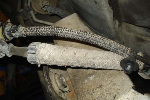99SportX
Explorer Addict
- Joined
- May 14, 2003
- Messages
- 2,009
- Reaction score
- 25
- City, State
- Duluth, MN
- Year, Model & Trim Level
- 1999 Ex & Mounty
I cant remember the thread size but I have 4 from when I put my OHV on the stand. The thread size is the same. I want to say it is a M10 but I am unsure of pitch (1.0 or 1.25?). I would remove one of the engine to trans bolts, take a look at the stand so you can figure out length and head to the store to match it.
I am eagerly following your thread. I hope to pull my SOHC and do a timing service so I can keep my engine running strong for years to come without issue. It has about 116k on it now and I hear a little rattle.
I am eagerly following your thread. I hope to pull my SOHC and do a timing service so I can keep my engine running strong for years to come without issue. It has about 116k on it now and I hear a little rattle.










